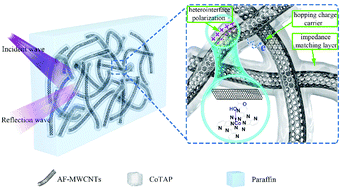Electromagnetic wave absorption properties of a carbon nanotube modified by a tetrapyridinoporphyrazine interface layer†
Abstract
Thinner absorbents with high dielectric loss usually cannot meet the requirement of impedance match, and multi-layer absorbents with excellent performance usually cannot be thin. Thus, it is a challenge to balance strong dielectric loss and impedance matching. An impedance matching interface layer can provide abundant interfaces, which are highly desirable for enhancing electromagnetic absorbing capability and decreasing surface reflection. In this study, cobalt tetrapyridinoporphyrazine (CoTAP) was assembled on the surface of multi-walled carbon nanotubes (MWCNTs) as a shell via a coordination bond; this produced a heterostructure and enhanced interfacial polarization loss at the hetero-interface. The impedance matching characteristic of the CoTAP–CNT hybrid can be optimized by the CoTAP shell with an intermediate conductivity. Contact resistance between CNTs can be increased via insulation owing to the CoTAP shell, which decreases surface EM reflection. When the CNT content of the CoTAP–CNTs hybrid is 30 wt% and the thickness of the absorber is 2.1 mm, the minimum value of the reflection coefficient and the corresponding frequency are −54.7 dB and 9.8 GHz, respectively. The combination of CNTs and the intermediate dielectric loss CoTAP in a core–shell hybrid can overcome the contradiction of strong dielectric loss and impedance matching of traditional materials; this can be considered as an effective route for designing high-performance EM absorbing materials.

- This article is part of the themed collection: 2017 Journal of Materials Chemistry C HOT Papers


 Please wait while we load your content...
Please wait while we load your content...